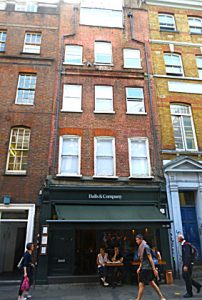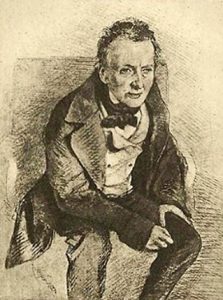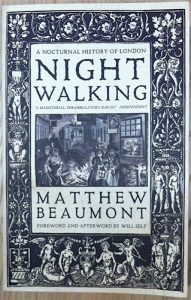I’ve recently been researching the life of Thomas De Quincey for a new cover illustration for Confessions of an English Opium Eater.
I was endeavouring to find out exactly where he lived in London during his famous 1802-03 stint when he lived as a vagrant and in absolute penury. It is thought that he perhaps wanted to imitate the life of a Romantic artist or poet, and chose to nocturnally wander abroad in the City, in part ‘to find himself’ and in part out of necessity… This was how De Quincey lived when he first came to London. He actually ‘resided’ (if one can call it that) at 58 Greek Street, Soho and here it is today…

Former residence of De Quincey: 58 Greek Street, Soho
A life-long Conservative, De Quincey was not born to poverty and actually absconded from the dry, intellectual life of his Manchester Grammar School at sixteen and a half, leaving there in the middle of the night. He ran back to his family in Chester, to try to persuade his domineering mother to give him an allowance of one guinea a week, for a ‘project’ to discover the “sweet pastoral hills” of Wales. An uncle intervened and he was successful, setting off to Wales from July to November 1802, living as a wayfarer. Unable to live on this money and rationing himself to ‘a single meal a day’ (tea or coffee in reality) he sometimes, ‘subsisted on blackberries, hips, haws, &c.’ Eventually reduced to absolute poverty, he slept behind hedges and under a small tent as nightly protection from the elements.
De Quincey soon became bored, lost touch with his family and his allowance was cut off. He decided to set off to London.
He reached the great Metropolis in late 1802, where he was ‘houseless and very seldom slept under a roof’. At this point he was very much a vagrant living on the London streets and must have been extremely vulnerable. He attempted to secure a £200 loan from moneylenders, with the intention of living off a £50 per year allowance until he reached the age of 21 and obtaining his inheritance. He failed, but managed to find somewhere to stay through the money lender Dell and his ‘handler’, a lawyer called Brunell or Brown, who himself led a nefarious life, sleeping in a different quarter of London every night to avoid bailiffs. Here at 58 Greek Street, Soho, De Quincey lived rent free but in abject poverty. It was a large unoccupied house whose only other occupant was a friendless child of about 10 years. She was the illegitimate daughter of Brown, indentured to him as his house servant and the writer described her as ‘hunger-bitten’. At night both huddled together against the cold under a horseman’s blanket. During the day though, De Quincey slept in parks and other places.
This was when he was often found upon Soho Square, Oxford Street and Great Titchfield Street, regularly meeting up with Ann —–, the young prostitute who saved his life at one point. It was then that I realised why: he was perhaps begging up and down Oxford Street, lit by it’s glittering shopping emporiums and from those wealthy customers frequenting such places (De Quincey never admits to this, yet this must be so). Or maybe he relied upon Ann to beg, as he saw himself a class apart from the poor. Oxford Street at this time was a well-known haunt of beggars and those engaged in the cadging ramble.
He left London in 1803 but returned in Autumn 1804, in Confessions of an English Opium Eater he said it was to try to find Ann – to no avail. But in the book perhaps he protests too much. For it has been suggested by Matthew Beaumont in his book (see below for details), that he never intended to find her, that he possibly never looked for her on his return. For De Quincey had always despised the poor and at this point had moved on somewhat. It was on his return, one day near Oxford Street, that he went into a druggist and purchased opium to cure his toothache….

De Quincey in later life
As a historian of the adjacent locality of St. Giles, I wanted to learn where else De Quincey wandered. By mapping these places (and based on David Masson’s research towards his biography on De Quincey), Joel Salt suggests we can understand the link between the geographical spaces, London topography and De Quincey’s unstructured and formless opium-induced writings. Mapping, Salt says, “holds the potential for new research methodologies that amplify cognition” (Digital 281 – see link below). I was fascinated that unlike Dickens who walked nocturnally for miles, De Quincey very much stayed in his small locality of St James Parish/Soho environment. Was this borne out of fear? He was certainly very class conscious: John Barrell wrote “De Quincey’s own fear of the working class…was very evident” and that he kept the “working poor under surveillance”. Thus he mainly wanders within an area surrounding his “conspicuous” mansion, in a historically wealthier area. He kept very close to home.
Yet why?
Possibly for safety. The notorious St. Giles Rookery was in extremely close proximity – only two streets away – and at this time was nearing it’s dangerous heights. Many cadgers, pickpockets and other criminals dwelt within it and as happens today, went about their business on Oxford Street and the wealthier parts of town. The invisible, yet very boundaried nightly wanderings of De Quincey might have consciously taken account of the fact that at this time, London was a very dangerous place to be abroad in the City.
There’s a few excellent chapters upon the nightly wanderings of Thomas De Quincey in a new book by Matthew Beaumont –
A Nocturnal History of Night Walking, published by Verso, London, 2016. I really enjoyed having a read through it.

A Nocturnal History of London Nightwalking – Matthew Beaumont
Can I also recommend this excellent research project to you upon De Quincey in London – Re-Mapping as Remembering: The Digital De Quincey by Joel Salt

Really interesting and great to read and glimpse into the characters od sohof. More please
de Quincey lived in Tavistock Street, Covent Garden, in a house that still exists. It has a plaque with his name wrongly spelled (no “e”).